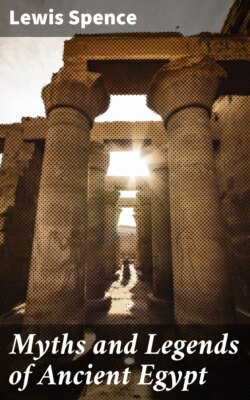Читать книгу Myths and Legends of Ancient Egypt - Lewis Spence - Страница 18
На сайте Литреса книга снята с продажи.
Mummification
ОглавлениеMummification was, as has been said, probably an invention of the Osirian cult. The priests of Osiris taught that the body of man was a sacred thing and not to be abandoned to the beasts of the desert, because from it would spring the effulgent and regenerated envelope of the purified spirit. In prehistoric times some attempt appears to have been made toward preservation, either by drying in the sun or smearing the corpse with a resinous preparation; and as the centuries went by this primitive treatment developed into the elaborate art of embalming, with all its gloomy, if picturesque, ceremonial. By the time of the Middle Kingdom, as is evidenced by the graves of Beni Hassan, the practice prevailed of removing the internal organs and placing them in a box divided into four compartments inscribed with the names of the four canopic deities who presided over them. In some burials of this date, to avoid the trouble of removing the intestines those responsible for the obsequies simply made up parcels which purported, by written descriptions upon them, to contain the organs in question, believing, doubtless, that the written statement that these bundles contained the heart, lungs, and so forth was magically efficacious, and quite as satisfactory as their real presence within the receptacle.
We do not find the process of mummification reaching any degree of elaboration until the period of the New Kingdom. At first it was confined to the Pharaohs alone, who were identified with Osiris; but the necessity for a retinue which would attend him in the dark halls of the Tuat prescribed that his courtiers also should be embalmed. The custom was taken up by the wealthy, and filtered down from rank to rank until at length even the corpse of the poorest Egyptian was at least subjected to a process of pickling in a bath of natron. The art reached its height in the Twenty-first Dynasty. At that period the process was costly in the extreme, and a mummification of an elaborate kind cost about £700 in modern currency. When the relations of the deceased consulted the professional embalmers they were shown models of mummies, one of which they selected. The corpse was then placed in the hands of the embalmers. First of all they injected a corrosive into the brain cavity, after which its softened contents were removed through the nostrils by hooked instruments. A mummifier, whose office rendered him almost a pariah, so sacred was the human body considered, made an incision in the corpse with a flint knife, a time-honoured instrument that seems eloquent of prehistoric practice. The intestines and the principal organs were then removed, washed, and steeped in palm wine. The body then underwent a drying process, and, according to the period, was stripped of its flesh, only the skin remaining, or was stuffed with sawdust, skilfully introduced through incisions, so that the natural form was completely restored. The cavity occupied by the organs might otherwise be stuffed with myrrh, cassia, or other spices. When sewn up the corpse was next pickled in a bath of natron for seventy days, and then meticulously bandaged with linen which had been dipped in some adhesive substance. A coffin was built for it which retained the shape of the human form, and which was gaily and elaborately painted with figures of divinities, amulets, symbols, and sometimes burial scenes. The carven countenance of the deceased surmounted this funerary finery, and the short wig, typical of the living Egyptian, glowed in gilded hues or in less costly colour above the conventional death-mask, which in general bore but little resemblance to him.
The canopic jars in which the intestines were placed had lids so carven as to resemble human heads, but subsequent to the Eighteenth Dynasty the heads of the four sons of Horus, the man-headed Mesti, the ape-headed Hapi, the jackal Tuamutef, and the falcon Qebhsennŭf, the 'genii' who guarded the north, south, east, and west, were represented upon their covers. In their respective jars were placed the stomach and larger intestines, the smaller intestines, the lungs and heart, and the liver and gall-bladder. These jars were placed in the tomb beside the mummy, so that upon resurrection it could easily command their contents. It is a striking circumstance that we discover a parallel to these 'genii' among the ancient Maya of Central America, who possessed four deities placed one at each point of the compass to uphold the heavens. Their names were Kan, Muluc, Ix, and Cauac, or, according to other authorities, Hobnil, Kanzicnal, Zaczini, and Hozanek, and it has been stated that the Maya made use of funerary jars called after these, bacabs, which held the internal organs of their dead.[9] Strangely enough, the ancient Mexicans also practised a description of mummification, as did the Peruvians.[10]
Model of a Funeral Boat with figures symbolizing Isis and Nephthys &
Canopic Jars representing the Four Sons of Horus—Photo W.A. Mansell & Co.
